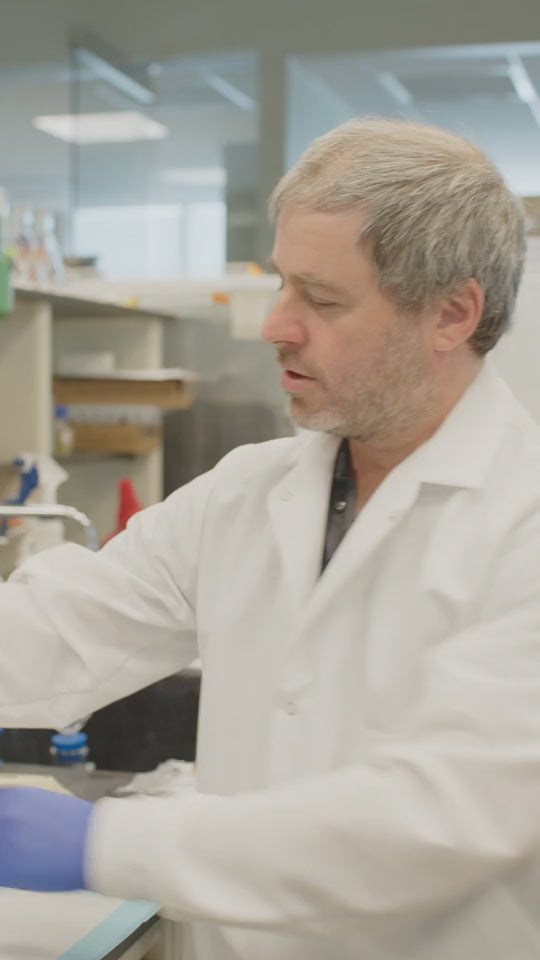Qi601™ Research: Barrier Protection and Binding of Microplastics and Nanoplastics
 Overview
Overview
Qi601 is a patented, novel, orally administered, non-living probiotic derived from an inactivated Lactobacillus fermentum (Qi6) is a probiotic strain cultivated under biofilm-promoting conditions to form self-aggregating, high-surface-area macrostructures (~200 µm in diameter). Qi6 is designated Generally Recognized As Safe (GRAS) by the FDA (GRN No. 0988), and Qi601 functions as a “Biofilm Shield™” in the gastrointestinal (GI) tract, binding microplastics (10 µm) and nanoplastics (100 nm). In laboratory tissue experiments, Qi601 binds micro and nanoplastics to prevent their interaction with colonic, intestinal epithelial cells, CaCO2 cells. Qi601 is large with an average sizes of 200 microns, and this biofilm sized particle is non-absorbable, enhancing its safety and efficacy as a physical barrier for gut-level plastic sequestration.
Key Research Findings
Microplastic and Nanoplastic Binding
- Qi601 in laboratory testing on human epithelial cell cultures, 83% of nanoplastics were prevented from binding to human epithelial cells and
got rid of it.
- In Vitro Evidence: Fluorescence microscopy demonstrates that Qi601 aggregates preferentially bind fluorescent microplastic (10 µm) and nanoplastic (100 nm) particles on microscope slides and in test tubes. Areas lacking Qi601 show no fluorescent signal, indicating high binding specificity.
- Dose-Dependent Adsorption: In test tube experiments, Qi601 adsorbed up to 87.6% of 100 nm nanoplastics at 3–4 mg concentrations, with adsorption stabilizing at higher doses due to saturation.
- Structural Advantage: The biofilm-like, 200 µm aggregates provide a high-surface-area matrix, enabling efficient capture of plastic contaminants.
Protection of Human Colonic Epithelial Cells
- Tissue Culture Model: In CaCO₂ human colonic epithelial cell cultures, Qi601 reduced microplastic adherence by 83% compared to untreated controls. Nanoplastics showed similar sequestration, with minimal epithelial attachment in experimental tissue couture plates when Qi601 was present.
Implications
Research indicates that Qi601 potentially offers a bio-inspired, non-systemic strategy to mitigate microplastic and nanoplastic exposure in the GI tract. With Qi601 binding contaminants as demonstrated in laboratory tissue culture plates, it reduces their interaction with epithelial cells, potentially lowering plastic absorption. Its GRAS status and scalable production make it a promising solution for addressing the growing environmental threat of plastic pollution.
Conclusion
Qi601 leverages its biofilm-like structure to act as an effective, safe, “Biofilm Shield™” for binding micro- and nanoplastics in the GI tract. In vitro and tissue culture studies provide robust evidence of its protective capabilities, positioning Qi601 as a novel and patented nutritional supplement.
U.S. Patent Coverage: Biofilm Cellular Mass for Barrier Protection
The unique manufacturing process that induces a biofilm phenotype and a biofilm cellular mass in all probiotics is protected under Quorum Innovations’ issued patents. This extends the company’s issued patented rights beyond Qi601, encompassing a class of microbiome-based therapeutics for protecting human barriers. and environmental sequestration agents designed around this patented principle. Biofilm probiotic phenotype across all strains are covered with over 50 patents issued in the Untied States and Internationally including the European Union via the via The Patent Cooperation Treaty (PCT) , China, Japan, Isreal, Korea, South American Countries.
Qi601 in the lab



